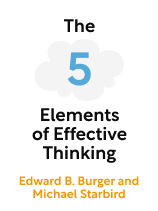

This article is an excerpt from the Shortform book guide to "The 5 Elements of Effective Thinking" by Edward B. Burger and Michael Starbird. Shortform has the world's best summaries and analyses of books you should be reading.
Like this article? Sign up for a free trial here.
What are your biases? Do you assume that something is true just because it’s what you’ve been told?
In The 5 Elements of Effective Thinking, award-winning educators Edward B. Burger and Michael Starbird emphasize that your view on a subject will, undoubtedly, have bias. They recommend using questions to look for bias in your perspective (not just your argument) and to guard against authority bias.
Keep reading to learn how to use questions to identify and eliminate your biases.
Use Questions to Identify Your Bias
What are your biases? Burger and Starbird recommend the following techniques to help you identify them.
1. Look for bias in your perspective, not just your argument. Reverse your beliefs and explore them. How would someone with the opposite perspective view this issue?
For example, say you’re an astrobiologist studying the viability of other planets for sustaining life. If you already believe there’s no life beyond Earth, that may affect the way you carry out your research and potentially impede your progress. Instead, decide one day that life beyond Earth does exist, and spend some time researching from that perspective. You may find that the opposing belief has more credibility than you once thought, or, at the very least, you’ll gain a deeper understanding of your original belief.
2. Watch out for authority bias. Don’t assume things are true just because that’s what you’ve been told.
The authors give the example of Aristotle claiming that objects of different weights will fall at different speeds and how that claim was widely accepted as true for over a millennium. Galileo Galilei famously decided to put this idea to the test and discovered that objects fall at the same velocity regardless of weight.
In doing so, he identified a bias in his foundational understanding: a claim he only believed because an authority had passed down that knowledge. When he questioned that claim and decided to test it for himself, he was able to fix a broken piece of his foundation.
| Authority Bias The authors don’t explicitly use the term authority bias, but that is the term for the tendency to believe information we receive from a source that we view as an authority. This type of bias can have far greater consequences than perpetuating misconceptions about gravity. Stanley Milgram is well-known for his experiment that demonstrated the effect of authority bias on our behavior. His intention was to study how humans were able to be convinced to carry out atrocities such as The Holocaust. The results demonstrated that a majority of participants obeyed orders to cause another person physical pain because they were told to do so by someone who seemed like an authority. This concept mirrors the ideas conveyed in the writings of Hannah Arendt, who coined the phrase “the banality of evil.” Arendt argued that most of the people who carried out the Holocaust were not psychopaths or people otherwise unbothered by human suffering, but were people who failed to examine and question the things they were being told to do by authority figures. She suggests that it is a lack of critical thinking that leads to such atrocities. Based on this, it seems logical that practicing a method of thinking that would dismantle this type of bias could not only benefit the individual in the way that Burger and Starbird describe, but could also serve to prevent large-scale destructive or harmful behavior such as war and genocide. Still, while Galileo’s method may have been ideal, most of us don’t have the resources to personally test every single piece of information we’re given. Especially since the internet has exploded our ability to share ideas, a vital tool in navigating all this information is being able to assess the reliability of a source of information. Questioning is perhaps the best way to accomplish this, and experts offer some specific methods of questioning to suss out how much credence you should put in a particular source. They specifically recommend that you assess: • Whether a source is offering information that is up-to-date • Whether it relates to what you’re trying to learn about • What expertise the source has on the matter • Where the source got its information • What reason the source had to put this information out there Sometimes a source is not only biased but is also engaging in deliberate misinformation to achieve personal or political goals. This type of misinformation or propaganda often appeals to our emotions in order to manipulate us and can often be identified using the same methods listed above. |

———End of Preview———
Like what you just read? Read the rest of the world's best book summary and analysis of Edward B. Burger and Michael Starbird's "The 5 Elements of Effective Thinking" at Shortform.
Here's what you'll find in our full The 5 Elements of Effective Thinking summary:
- The 5 principles for learning to think effectively
- What it means to learn beyond memorizing
- Why you need to be willing to change if you want to learn






